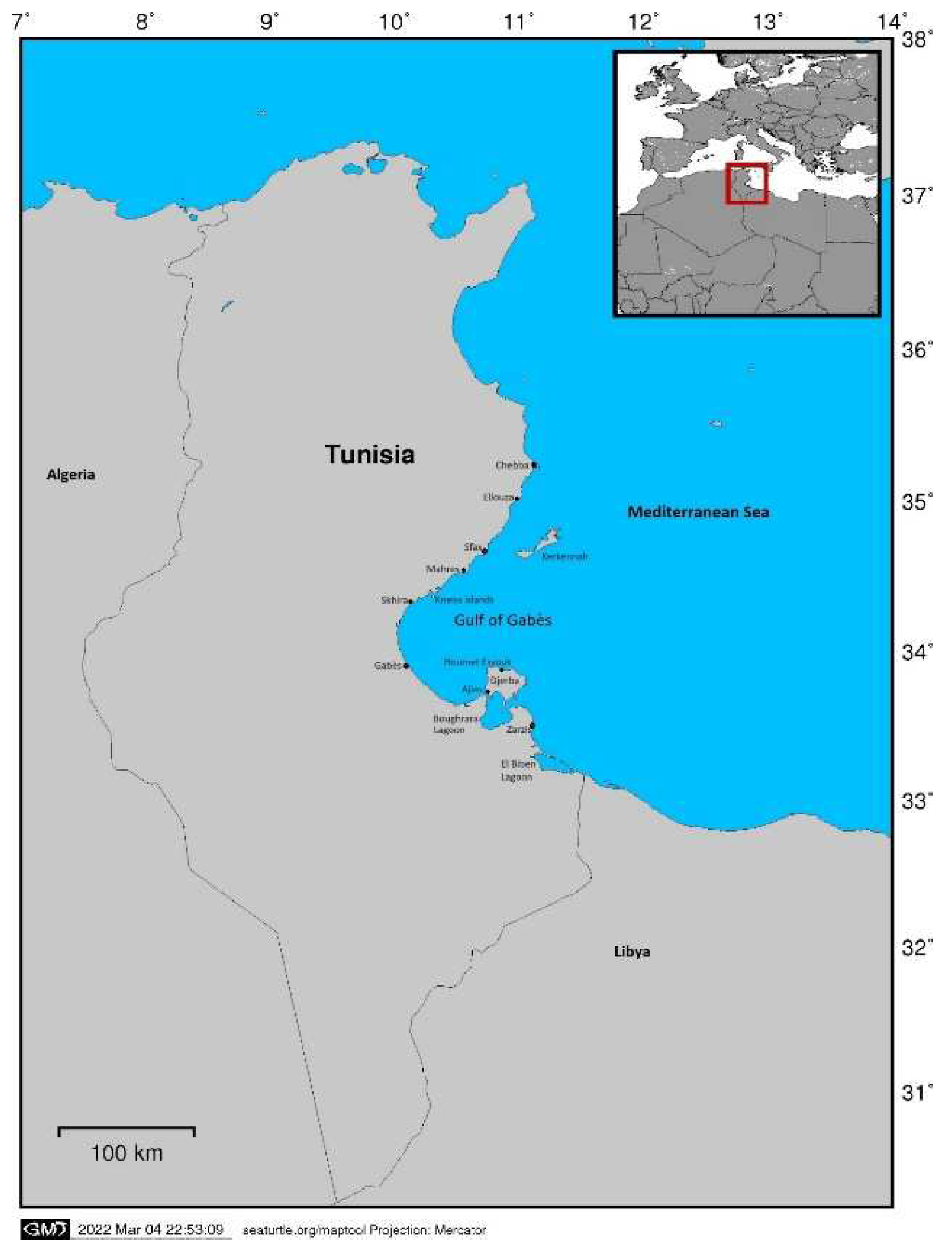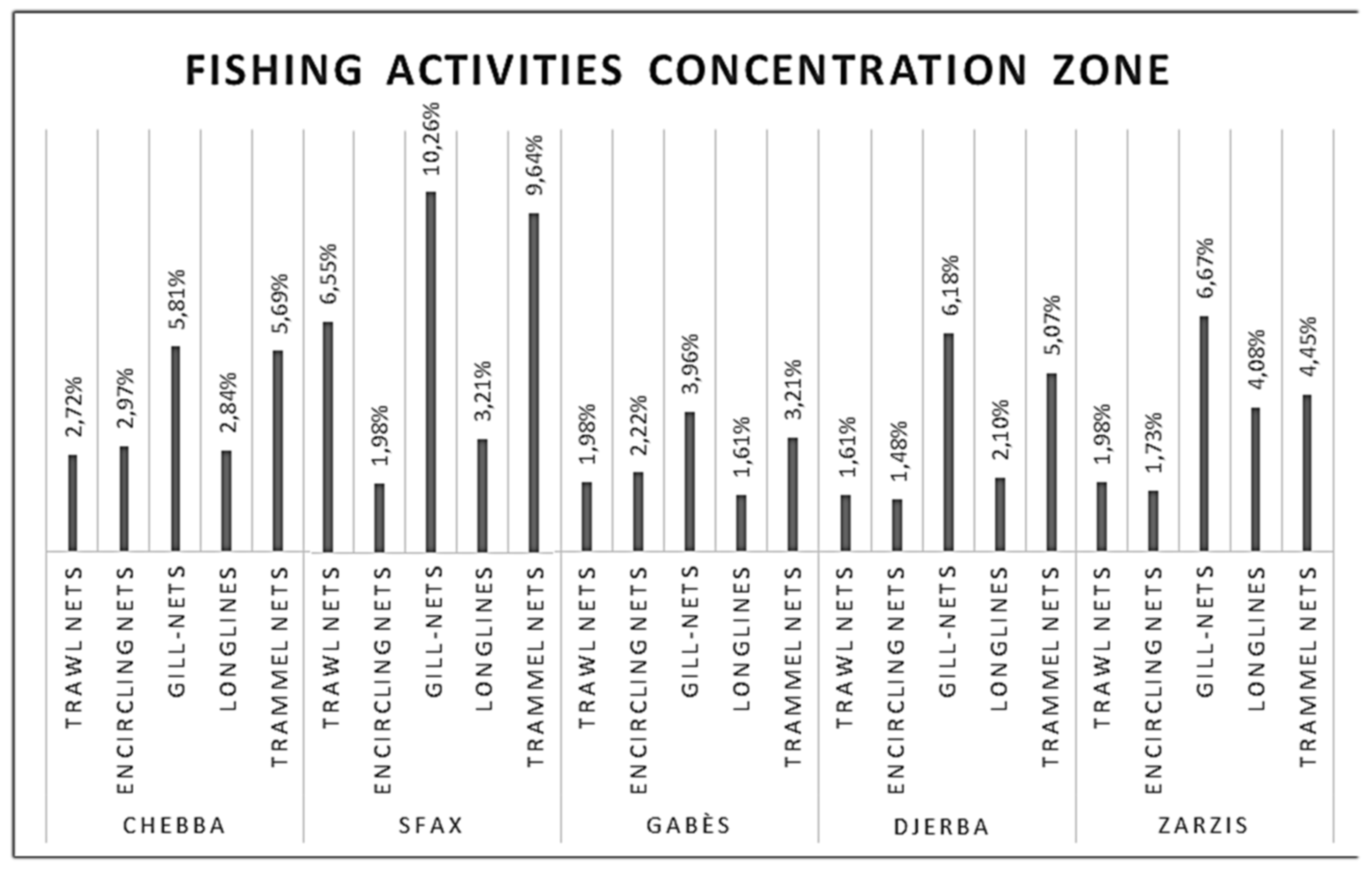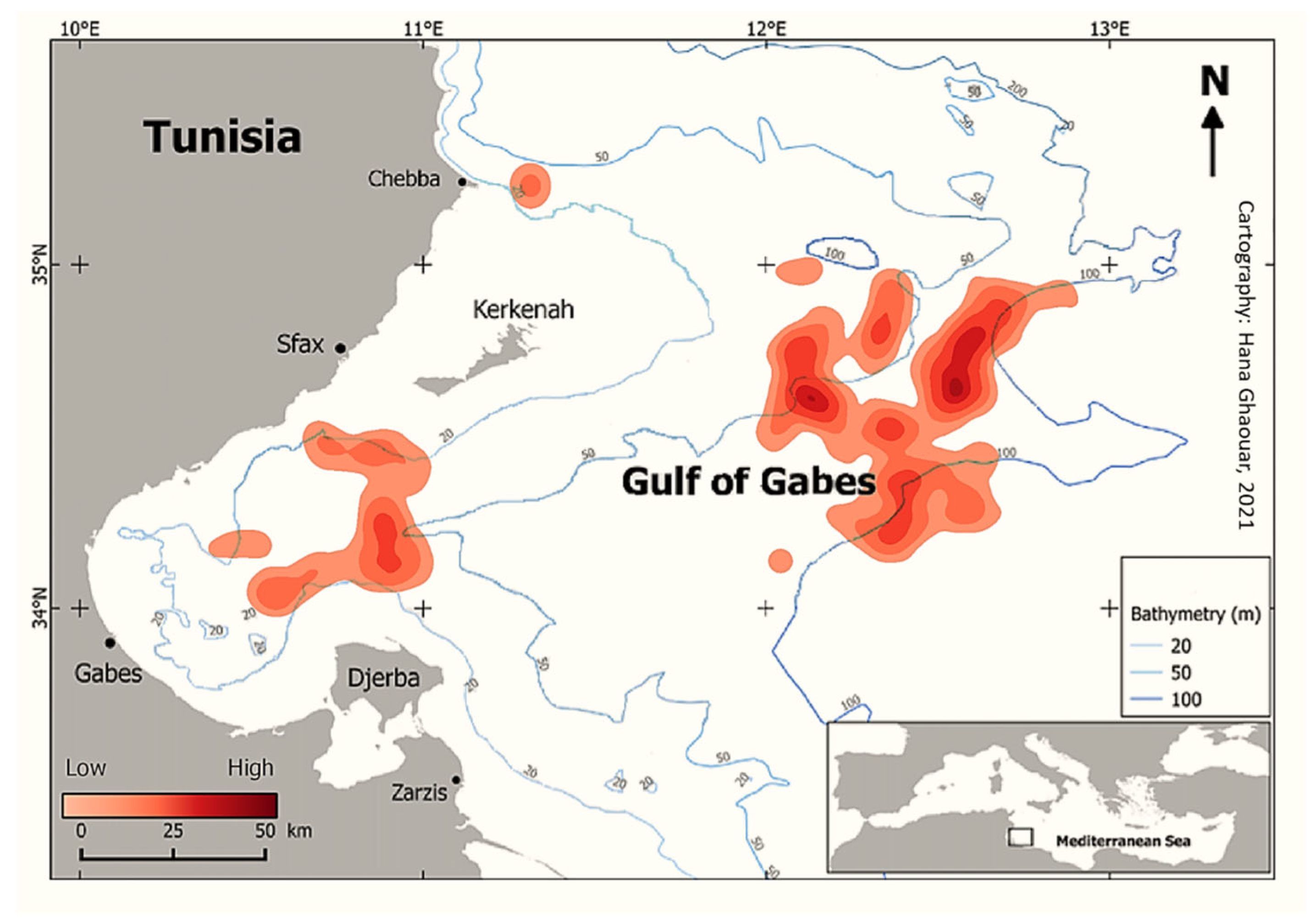Submitted:
05 February 2024
Posted:
05 February 2024
You are already at the latest version
Abstract
Keywords:
1. Introduction
2. Materials and Methods
2.1. Characterization of the Study Area
2.2. Method of Surveys and Data Analysis
3. Results
3.1. Analysis of Features by Fishing Types
3.2. Fishing Gears Loss Frequencies
3.3. Estimation of the Number of ALDFGs in the Gulf of Gabès
3.4. Causes of Loss
3.5. Spatial Distribution of ALDFGs in the Gulf of Gabès
4. Discussion
4.1. Fishing Gears Loss
4.2. Causes of Fishing Gear Loss
4.3. Spatial Distribution of ALDFGs
5. Conclusions
6. Patents
Supplementary Materials
Author Contributions
Funding
Institutional Review Board Statement
Informed Consent Statement
Data Availability Statement
Acknowledgments
Conflicts of Interest
References
- Richardson, K.; Asmutis-Silvia, R.; Drinkwin, J.; Gilardi, K.V.; Giskes, I.; Jones, G.; Barco, S. Building evidence around ghost gear: Global trends and analysis for sustainable solutions at scale. Mar. Pollut. Bull. 2019, 138, 222–229. [Google Scholar] [CrossRef] [PubMed]
- Suka, R.; Huntington, B.; Morioka, J.; O'Brien, K.; Acoba, T. Successful application of a novel technique to quantify negative impacts of derelict fishing nets on Northwestern Hawaiian Island reefs. Mar. Pollut. Bull. 2020, 157, 111–312. [Google Scholar] [CrossRef] [PubMed]
- Smolowitz, R.J.; Corps, L.N.; Center, N.F. Lobster, Homarus americanus, trap design and ghost fishing. Mar. Fish. 1978, 40, 2–8. [Google Scholar]
- Lively, J.A.; Good, T.P. Ghost Fishing. In World Seas: an Environmental Evaluation; Academic Press, 2019; pp. 183–196.
- Macfadyen, G.; Huntington, T.; Cappell, R. Abandoned, lost or otherwise discarded fishing gear. Food and Agriculture Organization of the United Nations FAO. 2009, No. 523.
- World Animal Protection. Ghosts Beneath The Waves. 2018, Accessed 1 March 2019. https://d31j74p4lpxrfp.cloudfront.net/sites/default/files/ca_en_files/ghosts_beneath_the_wavs_2018_ web_singles.pdf. 1 March.
- Stelfox, M.; Hudgins, J.; Sweet, M.A. Review of ghost gear entanglement amongst marine mammals, reptiles and elasmobranchs. Mar. Pollut. Bull. 2016, 111, 6–17. [Google Scholar] [CrossRef] [PubMed]
- Breen, P.A. Mortality of Dungeness crabs caused by lost traps in the Fraser River Estuary, British Columbia. North Am. J. Fish. Manag. 1987, 7, 429–435. [Google Scholar] [CrossRef]
- Kaiser, M.J.; Bullimore, B.; Newman, P.; Lock, K.; Gilbert, S. Catches in \'ghost fishing\'set nets. Mar. Ecol. Prog. Ser. 1996, 145, 11–16. [Google Scholar] [CrossRef]
- Erzini, K.; Monteiro, C.C.; Ribeiro, J.; Santos, M.N.; Gaspar, M.; Monteiro, P.; Borges, T.C. An experimental study of gill net and trammel net\'ghost fishing\'off the Algarve (southern Portugal). Mar. Ecol. Prog. Ser. 1997, 158, 257–265. [Google Scholar] [CrossRef]
- Cortés, J. Marine biodiversity baseline for Área de Conservación Guanacaste, Costa Rica: published records. ZooKeys. 2017, 652, 129–179. [Google Scholar] [CrossRef] [PubMed]
- Yıldız, T.; Karakulak, F.S. Types and extent of fishing gear losses and their causes in the artisanal fisheries of Istanbul, Turkey. J. Appl. Ichthyol. 2016, 32, 432–438. [Google Scholar] [CrossRef]
- Morzadec-Kerfourn, M. L'évolution des Sebkhas du golfe de Gabès (Tunisie) à la transition Pléistocène supérieur-Holocène. Quaternaire, 2002, 13, 111–123. [Google Scholar] [CrossRef]
- Coastal protection and development agency (APAL - Tunisia). New figures on the Tunisian coastline. [On line]. Available at: http://www.apal.nat.tn/site_web/indicateurs/nouveaux-chiffres%20_littorale-2015.pdf. 2015. (Accessed 4 June 2018).
- Amari, A. Contribution à la connaissance hydrologique et sédimentologique de la plateforme des Kerkennah. These de Doctorat, Fac. Sc. Tunis, Tunis, 1984.
- Climatique, A. Atlas climatique de l'Institut National de la météorologie. Conception et impression office de la topographie et de la cartographie, 1999.
- Béjaoui, B.; ben Ismail, S.; Othmani, A.; ben Abdallah-Ben Hadj Hamida, O.; Chevalier, C.; Feki-Sahnoun, W.; Harzallah, A.; ben Hadj Hamida, N.; Bouaziz, R.; Dahech, S.; et al. Synthesis review of the Gulf of Gabes (eastern Mediterranean Sea, Tunisia): Morphological, climatic, physical oceanographic, biogeochemical and fisheries features. Estuar. Coast. Shelf Sci. 2019, 219, 395–408. [Google Scholar] [CrossRef]
- FAO. The State of Mediterranean and Black Sea Fisheries. General Fisheries Commission for the Mediterranean. Rome, 2020. [CrossRef]
- Government of Tunisia. Sixth national report under the United Nations Convention on Biological Diversity. Submitted 14 March 2019. https://chm.cbd.int/database/record?documentID=243029 [accessed 12 October 2022].
- Anonyme, (2018). Annuaire des Statistiques des Pèches en Tunisie (Annee 2018). Direction Générale de la Pêche et de l'Aquaculture, Tunis.
- Santos, M.; Saldanha, H.; Gaspar, M. & Monteiro, C. Hake (Merluccius merluccius, L. 1758) ghost fishing by gill nets off the Algarve (southern Portugal). Fish. Res. 2003, 64, 119–128. [Google Scholar]
- Ayaz, A.; Acarli, D.; Altinagac, U.; Ozekinci, U.; Kara, A.; Ozen, O. Ghost fishing by monofilament and multifilament gillnets in Izmir Bay, Turkey. Fish. Res. 2006, 79, 267–271. [Google Scholar] [CrossRef]
- Kim, S.G.; Lee, W.I.; Yuseok, M. The estimation of derelict fishing gear in the coastal waters of South Korea: Trap and gill-net fisheries. Mar. Policy. 2014, 46, 119–122. [Google Scholar] [CrossRef]
- Chouchene, K.; Rocha-Santos, T.; Ksibi, M. Microplastic (MP) pollution in Sidi Youssef Harbor of the Kerkennah Islands, Sfax (Tunisia). In Environmental Science and Engineering; Springer International Publishing. 2021. [Google Scholar] [CrossRef]
- GGGI. Calao Africa - Sal Island Project. In: Global Ghost Gear Initiative [online]. 2018; [Cited 15 May 2021]. www.ghostgear.
- Brown, J.; Macfadyen, G.; Huntington, T.; Magnus, J.; Tumilty, J. Ghost fishing by lost fishing gear. Final Report to DG Fisheries and Maritime Affairs of the European Commission. Fish/2004/20. Institute for European Environmental Policy/Poseidon Aquatic Resource Management Ltd joint report, 2005; pp151.
- Khamassi, F.; Ghanem, R.; Khamassi, S.; Dhifallah, F.; Ben Souissi, J. Socio economic impacts of the Alien Invasive Crab Portunus segnis (Forskål, 1775) in the Gulf of Gabès (Tunisia). Rapp. De La Comm. Int. Pour L’exploration Sci. De La Méditerranée (CIESM) 2019, 42, 253. [Google Scholar]



| Port | Trammel net | Gill-net | Encircling net | Trawl net | Longlines | Total |
|---|---|---|---|---|---|---|
| Chebba | 44 | 48 | 23 | 32 | 16 | 163 |
| Ellouza | 5 | 11 | 0 | 0 | 1 | 17 |
| Mahres | 3 | 5 | 4 | 0 | 0 | 12 |
| Skhira | 5 | 5 | 2 | 0 | 0 | 12 |
| Sfax | 51 | 49 | 2 | 37 | 20 | 159 |
| Kerkennah | 24 | 20 | 0 | 0 | 1 | 45 |
| Gabès | 9 | 6 | 4 | 0 | 0 | 19 |
| Zarzis | 24 | 18 | 3 | 2 | 14 | 61 |
| Ajim | 6 | 5 | 0 | 0 | 0 | 11 |
| Houmet Essouk | 18 | 19 | 0 | 0 | 4 | 41 |
| Total | 189 | 186 | 38 | 71 | 56 | 540 |
| Fishing Gear Types | Tonnage of Fishing Boats (t) | Length of Fishing Boats (m) |
|---|---|---|
| Trawl nets | 50-100 (69.57%) 101-151 (27.57%) 152-202 (1.45%) 202-355 (1.45%) |
20-25 (84.51%) 25-30 (12.68%) 30-35 (1.41%) 35-40 (1.41%) |
| Encircling nets | 20-40 (68.57%) 40-60 (14.29%) 60-80 (11.34%) 80-100 (5.71%) |
10-15 (18.92%) 15-20 (40.54%) 20-25 (35.14%) 25-30 (5.41%) |
| Coastal fishing gears | 1-10 (69.59%) 10-20 (27.04%) 20-30 (4.37%) |
4-10 (58.67%) 10-16 (37.77%) 16-22 (3.56%) |
| Variables | Trawl nets | Encircling net | Gill-nets | Trammel nets | Longlines | |||||
|---|---|---|---|---|---|---|---|---|---|---|
| Mean | N | Mean | N | Mean | N | Mean | N | Mean | N | |
| 1 | - | - | - | - | 1.77 | 186 | 1.69 | 189 | 2.30 | 56 |
| 2 | 44.51 | 71 | 34.48 | 38 | 16.29 | 186 | 25.35 | 189 | 34.46 | 56 |
| 3 | 94.7705 | 71 | 28.51 | 38 | 10.15 | 186 | 10.50 | 189 | 12.70 | 56 |
| 4 | 23.9674 | 71 | 17.82 | 38 | 9.47 | 186 | 9.27 | 189 | 10.95 | 56 |
| 5 | 9.08 | 71 | 10.97 | 38 | 9.22 | 186 | 9.76 | 189 | 8.80 | 56 |
| 6 | 17.23 | 71 | 17.90 | 38 | 15.03 | 186 | 16.21 | 189 | 12.80 | 56 |
| 7 | - | - | 1097 | 38 | 35.56 | 186 | 74.71 | 189 | 2076.79 | 56 |
| 8 | 8.69 | 71 | 2.74 | 38 | 3.16 | 186 | 1.28 | 189 | 1.38 | 56 |
| 9 | 1.6516 | 71 | 1.54 | 38 | 3.03 | 186 | 10.71 | 189 | 8.82 | 56 |
| 10 | 3.13 | 71 | 1.23 | 38 | 1.30 | 186 | 1.92 | 189 | 1.61 | 56 |
| 11 | 1.56 | 71 | 1.097 | 38 | 4.30 | 186 | 12.20 | 189 | 401.96 | 56 |
| Constant | 1 | 2 | 3 | 4 | 5 | 6 | 7 | 8 | 9 | 10 | 11 | |
|---|---|---|---|---|---|---|---|---|---|---|---|---|
|
Trawl nets VIF |
- | - | 1.068 | 9.86 | 10 | 1.208 | 1.26 | - | 1.703 | 1.251 | 2.327 | 2.900 |
| Coefficient(B) | -4.390 | - | 0.032 | 0.018 | 0.168 | 0.084 | -0.01 | - | 0.121 | 0.324 | 0.462 | 0.45 |
| P-value | 0.021* | - | 0.003* | 0.022* | 0.108 | 0.329 | 0.701 | - | 0.038* | 0.139 | 0.000* | 0.000* |
|
Encircling net VIF |
- | - | 1.729 | 2.121 | 1.771 | 1.755 | 1.453 | 9.63 | 1.188 | 1.511 | 1.238 | 1.981 |
| Coefficient(B) | 2,584 | - | -0.039 | 0.001 | -0.024 | -0.062 | -0.053 | -0.553 | -0.116 | 0.301 | 0.016 | 0.909 |
| P-value | 0.237 | - | 0.042* | 0.962 | 0.639 | 0.597 | 0.186 | 0.784 | 0.396 | 0.346 | 0.945 | 0.000* |
|
Gill-nets VIF |
- | 1.248 | 1.374 | 2.019 | 2329 | 1.084 | 1,279 | 9.89 | 1.339 | 1.217 | 1.137 | 2.441 |
| Coefficient(B) | -21.934 | 0.223 | -0.043 | -0.059 | 0.313 | 0.329 | 0,707 | 0.292 | 0.418 | 0.475 | 4.567 | 0.596 |
| P-value | 0.000* | 0.775 | 0.457 | 0.243 | 0.126 | 0.078 | 0.000* | 0.014* | 0.207 | 0.005* | 0.000* | 0.000* |
|
Trammel nets VIF |
- | 1.671 | 2.868 | 2.013 | 2.944 | 1.151 | 1.163 | 4.554 | 1.779 | 1.429 | 1.478 | 3.052 |
| Coefficient(B) | 7.181 | -2.899 | 0.115 | 0.045 | -0.07 | -0.013 | 0.421 | 0.14 | -3.127 | -1.047 | 2.269 | 1.399 |
| P-value | 0.469 | 0.159 | 0.541 | 0.661 | 0.905 | 0.976 | 0.127 | 0.004* | 0.061 | 0.001* | 0.125 | 0.000* |
|
Longlines VIF |
- | 1.590 | 1.293 | 3.893 | 3.068 | 1.442 | 1.28 | 3.178 | 2.016 | 2.494 | 1.493 | 2.736 |
| Coefficient(B) | -2000.519. | 268.385 | 11.827 | 12.650 | -34.043 | -12.971 | 14.26 | 0.219 | 173.692 | 70.302 | 242.272 | 0.941 |
| P-value | 0.036* | 0.014* | 0.035* | 0.271 | 0.35 | 0.672 | 0.455 | 0.029* | 0.321 | 0.126 | 0.025* | 0.000* |
| Causes | Trawl net | Encircling net | Gill-net | Trammel-net | Longline |
|---|---|---|---|---|---|
| Bottom structure | 82% | 17% | 23% | 25% | 38% |
| Gear conflicts | 10% | 20% | 35% | 34% | 22% |
| Entaglement with animals | 6% | 49% | 30% | 29% | 13% |
| Weather conditions | 2% | 14% | 12% | 12% | 27% |
Disclaimer/Publisher’s Note: The statements, opinions and data contained in all publications are solely those of the individual author(s) and contributor(s) and not of MDPI and/or the editor(s). MDPI and/or the editor(s) disclaim responsibility for any injury to people or property resulting from any ideas, methods, instructions or products referred to in the content. |
© 2024 by the authors. Licensee MDPI, Basel, Switzerland. This article is an open access article distributed under the terms and conditions of the Creative Commons Attribution (CC BY) license (http://creativecommons.org/licenses/by/4.0/).





